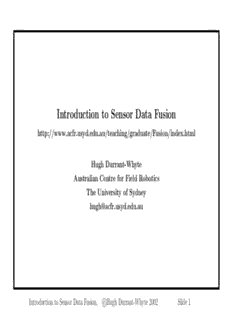Table Of ContentIntroduction to Sensor Data Fusion
http://www.acfr.usyd.edu.au/teaching/graduate/Fusion/index.html
Hugh Durrant-Whyte
Australian Centre for Field Robotics
The University of Sydney
[email protected]
(cid:1)
Introduction to Sensor Data Fusion, c Hugh Durrant-Whyte 2002 Slide 1
Introduction
•
Data fusion is the process of combing information from a number of different sources to provide a
robust and complete description of an environment or process of interest
•
This course provides an introduction to data fusion methods. The focus is on mathematical
methods in probabilistic and estimation-theoretic data fusion.
•
The course is a cut-down version of a full three day course. The full course includes
computer-based laboratories which provide the opportunity to implement and evaluate
multi-sensor tracking, estimation and identification algorithms
•
Course Content
•
Reference Material
(cid:1)
Introduction to Sensor Data Fusion, c Hugh Durrant-Whyte 2002 Slide 2
Course Content
1. Probabilistic Data Fusion
•
Probabilistic Methods
•
Information Measures
•
Alternatives to Probability
2. Multi-Sensor Estimation
•
The Kalman Filter
•
The Multi-Sensor Kalman Filter and Track-to-Track Fusion
•
Non-linear Data Fusion Methods
•
Multi-Sensor Multi-Target Data Association
3. Distributed and Decentralised Data Fusion Systems
•
Data Fusion Architectures
•
Decentralised Estimation
(cid:1)
Introduction to Sensor Data Fusion, c Hugh Durrant-Whyte 2002 Slide 3
Laboratory Sessions (not done here)
•
Laboratory 1: Probabilistic and Information Data Fusion Methods
•
Laboratory 2: Multi-sensor multi-target tracking
•
Laboratory 3: Decentralised Data Fusion
•
Code freely available at: http://www.acfr.usyd.edu.au/teaching/graduate/Fusion/index.html
(cid:1)
Introduction to Sensor Data Fusion, c Hugh Durrant-Whyte 2002 Slide 4
Recommended Reference Material
•
Blackman: probably the most comprehensive book on data fusion methods. covers both level 1-2
multi-target tracking and identification problems as well as level 3-4 methods in situation
assessment and sensor management. Notably, it covers a number of current military systems in
some detail and gives develops a number of specific examples of multi-sensor systems.
•
Waltz and Linas: something of a classic in the field. Consists of mainly qualitative descriptions
of various data fusion systems (with an emphasis on military systems).
•
BarShalom: a number of books on data fusion and tracking, including his classic book on
tracking and data association, and his two edited volumes on data fusion.
•
Artech House series: a specialist publishing house in the radar, data fusion and military
systems area.
(cid:1)
Introduction to Sensor Data Fusion, c Hugh Durrant-Whyte 2002 Slide 5
Probabilistic Data Fusion
(cid:1)
Introduction to Sensor Data Fusion, c Hugh Durrant-Whyte 2002 Slide 6
Probabilistic Data Fusion
•
Uncertainty lies at the heart of all descriptions of the sensing and data fusion process.
•
Probabilistic models provide a powerful and consistent means of describing uncertainty and lead
naturally into ideas of information fusion and decision making.
•
Alternative uncertainty measurement methods also described.
•
A brief review of probabilistic methods
•
A focus on probabilistic and information theoretic data fusion methods and architectures
(cid:1)
Introduction to Sensor Data Fusion, c Hugh Durrant-Whyte 2002 Slide 7
Probabilistic Models
•
Familiarity with essential probability theory is assumed
• ·
A probability density function (pdf ) P ( ) is defined on a random variable y,
y
•
generally written as P (y) or simply P(y)
y
•
The random variable may be a scalar or vector quantity, and may be either discrete or continuous
in measure.
•
The pdf is a (probabilistic) model of the quantity y; observation or state.
•
The pdf P(y) is considered valid if;
1. It is positive; P(y) > 0 for all y, and
2. It sums (integrates) to a total probability of 1;
(cid:1)
P(y)dy = 1.
y
•
The joint distribution P (x,y) is defined in a similar manner.
xy
(cid:1)
Introduction to Sensor Data Fusion, c Hugh Durrant-Whyte 2002 Slide 8
Joint Probabilistic Models
•
Integrating the pdf P (x,y) over the variable x gives the marginal pdf P (y) as
xy y
(cid:1)
P (y) = P (x,y)dx,
y xy
x
•
and similarly integrating over y gives the marginal pdf P (x).
x
• ···
The joint pdf over n variables, P(x , ,x ), may also be defined with analogous properties to
1 n
the joint pdf of two variables.
• |
The conditional pdf P(x y) is defined by
P(x,y)
(cid:5)
|
P(x y) =
P(y)
•
Has the usual properties of a pdf with x the dependent variable given that y takes on specific fixed
values.
• |
The conditional pdf P(y x) is similarly defined.
(cid:1)
Introduction to Sensor Data Fusion, c Hugh Durrant-Whyte 2002 Slide 9
The Total Probability Theorem
•
Chain-rule can be used to expand a joint pdf in terms of conditional and marginal distributions:
|
P(x,y) = P(x y)P(y)
•
The chain-rule can be extended to any number of variables
··· | ··· ··· |
P(x , ,x ) = P(x x ,x ) P(x x )P(x )
1 n 1 2 n n−1 n n
•
Expansion may be taken in any convenient order.
•
The Total Probability Theorem
(cid:1)
|
P (y) = P (y x)P (x)dx.
y x|y x
x
•
The total probability in a state y can be obtained by considering the ways in which y can occur
|
given that the state x takes a specific value (this is encoded in P (y x)), weighted by the
x|y
probability that each of these values of x is true (encoded in P (x)).
x
(cid:1)
Introduction to Sensor Data Fusion, c Hugh Durrant-Whyte 2002 Slide 10
Description:This course provides an introduction to data fusion methods. The focus Artech
House series: a specialist publishing house in the radar, data fusion and military.

